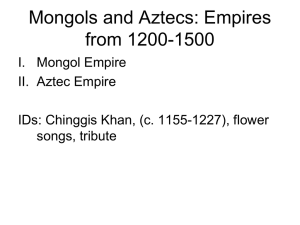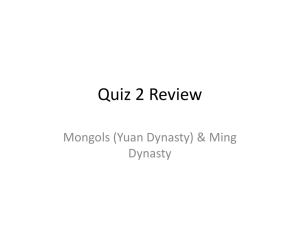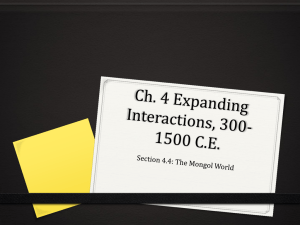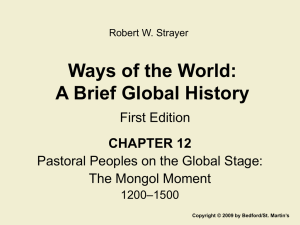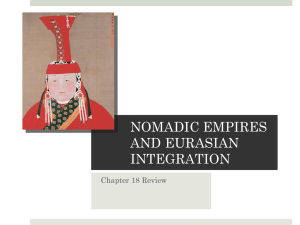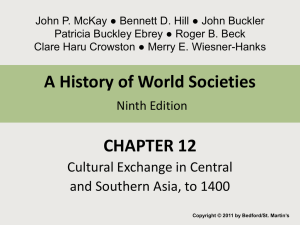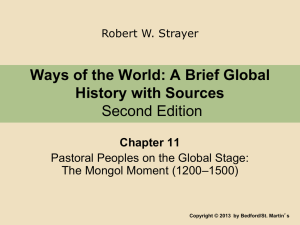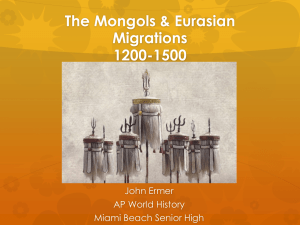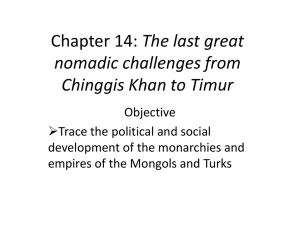The Mongols
advertisement
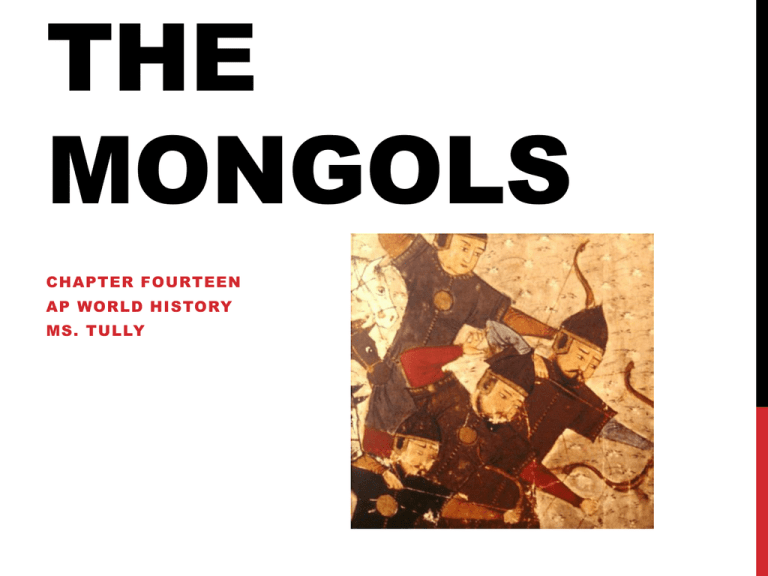
THE MONGOLS CHAPTER FOURTEEN AP WORLD HISTORY MS. TULLY STEPPES OF CENTRAL ASIA Mongols homeland good for grazing/herding Xiongnu; Turks PRE-MONGOL EURASIA MONGOL SOCIETY Nomadic society; herding based Life in the saddle Tribal society w/ kin-based clans Women had higher status Mongols valued military skills; warrior code of bravery MONGOL FIGHTERS All cavalry army; excellent w/ short bows Later developed siege technology Speed; mobility Yam System – relay messages Spies & informations used to create maps Tumen: fighting unit of 10,000 warriors 13th C: Best army in the world CHINGGIS KHAN Temujin (11621227) 1206: Kurlitai elected khagan Organized Mongols into confederation Common task: conquer the world EARLY CAMPAIGNS 1207: first military campaign leads to defeat of Xi Xia kingdom, Jin Empire 1219: Conquer Kara Khitai Empire and Khwarazm Empire Mongols known for their devastation Valued artisans & scholars; killed or sold others into slavery GROWTH OF THE MONGOL EMPIRE THE MONGOL EMPIRE OF CHINGGIS KHAN Established capital at Karakorum Religions and cultures tolerated by Mongols Script devised for Mongolian script Mongol conquests brought peace to regions Secure & monitor trade routes Tribute based empire DEATH OF CHINGGIS KHAN 1226: Khan took army of 180K to complete conquest of China 1227: Chinggis Khan dies Remaining land divided 4 ways: between 3 sons and grandson Son Ogedei becomes Great Khan FOUR KHANATES Mongol empire divided into four khanates • Golden Horde • Chaghatai/Djagtai Empire • Il-khan Empire • Yuan Dynasty (Kubilai Khan) CENTRAL ASIA: CHAGATAI EMPIRE Led by Chagtai Khan Founded 1225; lasts until 1678 Weakened in 1360s; Timur, subkhanates RUSSIA: THE GOLDEN HORDE Golden Horde khanate led by Batu 1236: Invasion of Russia; also 1237, 1238, 1240 Eventual goal conquer Europe Russian princes became vassals of khan pay tribute Peasants Serfs Russia isolated from Western European influence (Renaissance) Growth of Moscow 1380: Battle of Kulikova Political and military influence of Mongol rule MIDDLE EAST: ILKHAN EMPIRE Hulegu leader of Il-khan Empire 1258: Destruction of Baghdad & Abbasid Caliphate Tolerant of scholars/artisans Greater assimilation into Persian culture Reinvigorated Eurasian trade routes Mongols defeated by Mamluks of Egypt in 1260 Berke (khan of GH) converted to Islam CHINA: YUAN DYNASTY Mongols conquered Xi Xia & Jin Empires, turned next to Song Dynasty 1235: Kubilai Khan leads forces against Song Dynasty 1271: Mongols rule most of China Yuan Dynasty Capital at Tatu (Beijing) MONGOL RULE IN YUAN CHINA Legal separation of Chinese and Mongols Mongols do adopt Chinese clothing; art Mongol women did not practice Chinese customs and held more freedoms; Chabi an important advisor to KK Social standing in Yuan Dynasty • Mongols • Muslims and Asian nomads • Chinese Chinese were able to hold local/regional gov’t positions Merchants and artisans rose in status under Mongol rule Yuan court welcomed foreigners; religious toleration Chinese resistant to Mongol rule FALL OF YUAN CHINA Mongol rule lasted for 90 years Corruption & indulgence at court; widespread banditry and piracy Peasant resistance – White Lotus Society 1398: Zhu Yuanzhang Ming Dynasty SIGNIFICANCE OF MONGOL EMPIRE Largest land empire in history Pax Mongolia (13th-14th C) Facilitated Silk Road between Asia and Europe Spread Bubonic Plague TIMURID EMPIRE Timur the Lame (Tamerlane) Turkic leader Active during Mongol decrease of power in Eurasia Samarkand = capital; famed for architectural beauty Incredibly violent Last nomadic incursion; die 1405


